
A cardiac arrest is a serious health emergency where immediate action really can make the difference between life and death.
Despite around 30,000 cardiac arrests happening each year, St John Ambulance says not enough people are using defibrillators when needed. When someone has a cardiac arrest, their heart stops beating. They will collapse, their breathing may become irregular or stop altogether, and they won't respond to anything. This is where knowing the three life-saving ‘Ps’ - phone, push, press - is vital.
'Phone' means dialling 999. 'Push' is about starting chest compressions to keep the heart and brain supplied with oxygen. 'Press' is about pressing the button on a defibrillator to give the casualty a shock. David Bowen, who leads on resuscitation at St John Ambulance, said: "A cardiac arrest can happen to anyone at any time, and the sooner a person receives chest compressions (CPR) and defibrillation, the higher their chances are of survival. The worst thing you can do in a cardiac arrest emergency is do nothing. 'Phone, push, press' is a simple and catchy reminder of the actions you need to take and we hope will help save more lives."
Research published last year found that 74 per cent of people know how to do CPR, also known as cardiopulmonary resuscitation. But despite this, a mere 44 per cent of people would actually feel confident performing CPR if someone was in cardiac arrest.
How to perform CPR on an adult
The British Heart Foundation says you should act immediately if the patient is:
 Strictly star Saffron Barker's brother in hospital after 'major heart attack'
Strictly star Saffron Barker's brother in hospital after 'major heart attack'
- Unconscious
- Unresponsive
- Breathing irregularly
After calling 999, you can start chest compressions.
- Place the heel of your hand in the middle of their chest and press down smoothly and firmly at a rate of 2 times per second.
- Try pushing to the beat of Stayin' Alive by the Bee Gees.
- Use a defibrillator as soon as possible.
- Follow its instructions carefully while continuing to give CPR.
How to perform CPR on a child
Always call 999 before starting CPR, says the British Heart Foundation
- Turn the child on their back, open their mouth and gently tilt their head back enough to open the airway. Support their neck while you do this.
- Pinch their nose, seal their mouth with your mouth and breathe out firmly until their chest rises. Wait for their chest to fall before giving the next breath. At first, give 5 of these rescue breaths.
- Put one hand in the centre of the child’s chest (aim for their breastbone). Push down on their chest about one third deep (about 5cm) at a rate of 2 per second. Repeat this 15 times to a steady and swift beat (try pushing to the beat of Stayin’ Alive by the Bee Gees). Allow the chest to come back up before you push each time.
- After doing 15 chest compressions, give 2 rescue breaths. Keep repeating this cycle.
- Once you have a defibrillator, place the pads on the child immediately and turn it on. If someone is with you, they can do this while you continue to do CPR. Follow the defibrillator’s instructions. If you do not have a defibrillator, keep doing CPR.
How to do CPR on a baby (under 1 year old)
Again, always call 999 before starting CPR.
- Turn the baby on their back and open their mouth.
- Cover their nose and mouth with your mouth and breathe out firmly until their chest rises. Wait for their chest to fall before giving the next breath. At first, give 5 of these rescue breaths. If you cannot get a good seal over the mouth and nose, then cover either the mouth or the nose. Make sure the part you’re not covering is closed.
- Use two thumbs in the centre of the baby's chest (aim for the breastbone). Push down on their chest about one third deep (about 4cm) at a rate of 2 per second. Repeat this 15 times to a steady and swift beat (try pushing to the beat of Stayin' Alive by the Bee Gees). Allow the chest to come back up before you push each time.
- After doing 15 chest compressions, give 2 rescue breaths Keep repeating this cycle.
- Once you have a defibrillator, place the pads on the baby immediately and turn it on. If someone is with you, they can do this while you continue to do CPR. Follow the defibrillator’s instructions. If you do not have a defibrillator, keep doing CPR.
Read more similar news:
Comments:
comments powered by Disqus

































